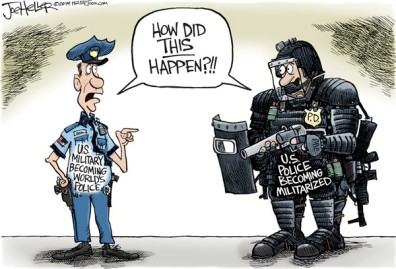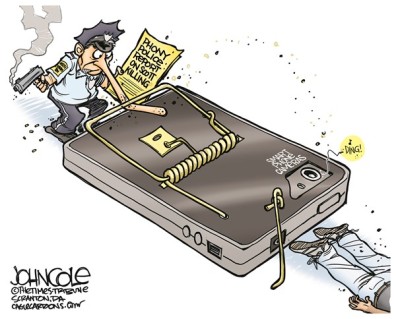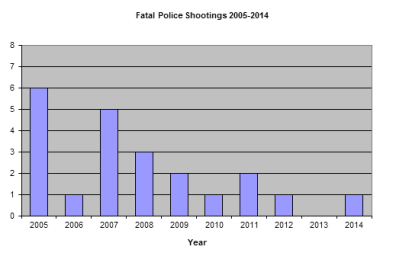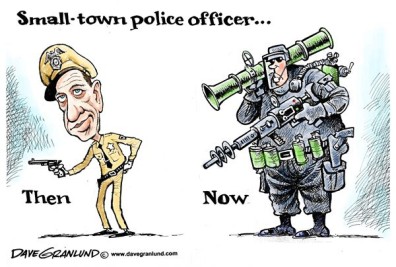Police Shootings: Stress or Militarization?
zack.burkhartOver the past several years, it seems as if police shootings have become a more frequent current event. Police shootings can occur for a number of reasons; however what the public only knows is not very much. Knowing that a police profession is a stressful career and due to recent implementations of militaristic tactics; could one or both of these be the cause for hundreds, almost thousands of people being shot and killed by police?
Since the beginning of 2015 until the current day, approximately a total of 921* people have been killed by police in the United States. Out of the 921 people who have been killed, only 48% consisted of a white person, whereas blacks made up 27% of the 921 people killed. However, media does not have the tendency to illustrate that whites have been killed by police more than blacks or any other race. No surprises at all, this year thus far, 96% of those killed by police have been a male, where 4% was a female. Roughly, seventy-five percent of the 921 killed was a result from a violent crime. These violent crimes include: shootouts, stabbings, hostage situations, carjacking, and assaults” (Washington Post, 2015). Violent crimes are known to lead to high-risk situations. Events like having to deal with these kinds of situations also, make the profession of a police officer extremely stressful.
Everybody gets stressed out over things whether it is the tiniest thing or some major problem. With that said, police officers are faced with stressful situations daily. From a simple traffic potentially turning south or to having to deal with an outraged individual in the event of a domestic violence call, police are at risk twenty-four-seven. Based upon these situations, depends on how the officer is able to handle themselves when these stressful situation come about. “Stress reactions and burnout also are seen more frequently in patrol officers who must handle large number of calls that involve serious problems which they are not equipped by training or mandate to solve” (Katherine W. Ellison, 1983, 60). Not only that, but, when police respond to a call, they basically are going into the situation blind, not knowing what they are going to find once they arrive on the scene. The best thing police officers can hope for is to resolve the situation as calmly as possible without causing an outburst or causing tensions to rise between the suspect and the officer. Overall, there is a general consensus that police work is stressful.
When the police was first implemented into our society, police were given very minimal number of duties and equipment while enforcing the law. Back then, police were given a baton, handcuffs or some sort of restraints, and that was pretty much all they had. Police today however; carry much more than that. Typically, a gun, extra magazines, a taser, pepper spray, several pairs of handcuffs, a radio, sometimes a baton and more equipment, if the officer wishes to do so, can be found on a police officer in today’s society. In high tense situations, police can be known to breakout the “heavy” equipment. Normally, this can consist of a military grade type rifle (AR-15 or M-4), shields, full body gear, basically, anything possible to cover them from head to toe. This kind of gear usually does not come out unless there is a riot or protesting. “Over the past three decades law enforcement management and policing models have become increasingly militarized in philosophy and practice, which has precipitated a change in the breadth and depth of urban policing” (Daryl Meeks, 2006, 36). Clearly police are trying to improve the tactics in which they use, but, is all this necessary?
Police are constantly going about their day acting like the job in which they do, is not stressful, however; the truth being, it actually is stressful. Similar to that, police today are also, implementing militarization in order to resolve chaotic situations. Was there a connection relating police shootings to stress or militarization? Well, it was unclear in the findings, but, a well-educated guess would conclude in some aspects stress is a major factor however; militarization is not clear-cut as to if it plays a factor into police shooting. Stress can be seen as a result for police shootings because of the high-risk situations the police are headed into when they answer the call of service. The improvement of militarization amongst the police can be seen as last result in hopes of scaring the public; think about it. If you were protesting then see a group of people in full protection coming at you with shields as well, whereas a civilian you basically do not have anything but to turn around and to run as far as possible. In the end, it is believe that stress plays more of a factor in seeing an increase of police shootings.
*Over time statistics are going to change, at the time of writing this 921 was the current number, however; most likely that number has increased. If wanted to see for yourself feel free to by visiting the following link: https://www.washingtonpost.com/graphics/national/police-shootings/
Sources:
Ellison, K., & Genz, John L. (1983). Stress and the police officer. Springfield, Ill., U.S.A.: C.C. Thomas.
Meeks, D. (2006). Police Militarization in Urban Areas: The Obscure War Against the Underclass. The Black Scholar, 35(4), 33-41.
Washington Post (2015). Retrieved: (December 14, 2015). https://www.washingtonpost.com/graphics/national/police-shootings/
Images:
All images copyright google image search






